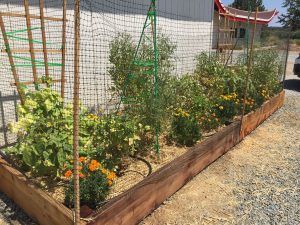Its Almost Zucchini Season
The season is almost upon us, the midnight drops off on the front porch, then a shadowy figure fades away. Perhaps your doorbell camera alerts you or the next morning you discover a box of zucchinis waiting for you. Zucchini squash is probably the most night-delivered vegetable known to mankind.
Squash is prolific, wonderful, and delicious. It may be made into bread, barbecued, baked, fried, filled like a canoe, “zoodled” and, when it reaches gargantuan size, fed to joyful chickens. We always think about green zucchini since those seem to be distributed freely, but there are over 40 varieties of summer squash. Seed catalogs have pages of summer and winter squash available.
Squash has been shared for hundreds of years in the United States, all the way back to the American Indians. The Indians grew gourds, squash, and pumpkins. All three of these plants like the same growing conditions: lots of sun, lots of organic materials and space to grow. The root system on squash needs room to supply the large stems, leaves and fruit. Squash has two different types of flowers, males and females. The males will appear first, followed by the females about a week later. The female flower will have a small bump or upcoming squash, just under the flower. The flowers are edible, to be enjoyed in salads, fried or sautéed. If the flowers are your favorite, remember to save enough boys and girls for later fruit.
Squash is easy to start. Planting seeds indoors under lights will give you a head start. Remember to look up your annual frost date and give the soil time to warm. Rushing to plant veggies while the soil is still cold will leave the plants shivering and stalled out. The best instructions are on the seed packet. The seed packet will provide seed depth, sprouting time, temperatures, light requirements and spacing.
Summer squash varieties have different colors, shapes, and sizes. The basic squash is yellow or green, with different shading. There are straight necked, lemon drops, egg shaped, round, crook necked and UFOs. UFO is another description for patty pan or scalloped. They do look like UFOs!
New varieties beyond green zucchini from yesteryear are numerous and delicious. Golden Scallopini is yellow with scalloped edges growing on a bush type plant. They will take 55 to 65 days to produce – then watch out, they are prolific! Ronde de Nice is a round French heirloom with green and white variegated leaves. Delicious for stuffing and take 50 days to produce. Black Beauty looks like zucchini from old but grows 3 to 4 feet tall with an open stance, making it easier to spot the straight fruit. They are best enjoyed when the fruit is 6 to 8 inches long. If you choose to grow your squash in a pot or have a small garden try Bush Baby, a small, compact plant bred to produce smaller fruit and plants. Bush Baby has a delicate flavor and is best if picked at 6 inches long. Lemon squash looks like it will be a favorite for years with the shape, size and lemon color. According to the seed grower, lemon squash has the best insect resistance.
Summer squash is a source of vitamin A and C, niacin, and magnesium. Squash is easy to grow and loves our heat. Perhaps you will find a variety that you will refuse to give away.
I’m leaving you with an old wives’ tale about squash. To keep raccoons out of your corn, plant winter squash between the corn rows. Raccoons have sensitive feet and do not like stepping on the prickly squash leaves. It saves your corn and irritates the raccoons – just a perfect squash plan.
Julie Silva is a University of California Cooperative Extension Master Gardener of Tuolumne County.
Gardeners from Tuolumne and Calaveras Counties can answer home gardening questions, call 209-533-5912 Fill out our easy-to-use problem questionnaire here. Check out our website here, You can also find us on Facebook.

